- Created by Chellie Esters , last modified on Jun 07, 2020
You are viewing an old version of this content. View the current version.
Compare with Current View Version History
« Previous Version 5 Next »
The Location Analysis tab displays your top 10 regions and top 15 locations by facilities spend. You can also view your facilities spend on a map to quickly compare the depths of spend across global regions. This data shows work orders over the past 365 days, by default. Use the all-inclusive filters along the top of the report to change the date range, or to focus on specific Trades and Categories.
You can download the data and email reports to recipients.

In this dashboard you can review:
- Count of Active Locations
- Region Analysis - Top 10 by Total Invoice Amount
- Top 15 Locations Report
- Work Order Count by State and Average Invoice Amount by State
Count of Active Locations

This visualization displays the number of Locations with at least 1 work order entered during the selected date range. By default, this chart displays this data over the past 365 days; use the all-inclusive filters along the top of the report to change the date range.
Clicking the number drills down into a list of all work orders and includes:
- work order details such as Status, Trade, Category, and Location
- work order completion date
- NTE
- Invoice Amount
- Committed Spend
Clicking the tracking number navigates you the work order details page in Service Automation.
Your access within Service Automation dictates your access to the work order details.
Region Analysis - Top 10 by Total Invoice Amount
This visualization clusters Regional invoicing so you can view the Regions with higher or lower facilities spend. It clusters three-dimensional data for your top 10 Regions: Invoice Amount, Average Invoice Amount, and Number of Work Orders by Region.
Both voided work orders and work orders with an empty Status are excluded.
Each bubble represents a Provider — the more Work Orders for that Provider, the larger the size of the bubble.
Hovering over a bubble lists the Total Invoice Amount for that Provider, the Provider name, the Average Invoice Amount, and the total Work Order Count. Clicking the bubble allows you to explore all underlying data, or filter by Trade, District, or Asset.
By default, this chart displays this data over the past 365 days; use the all-inclusive filters along the top of the report to change the date range.
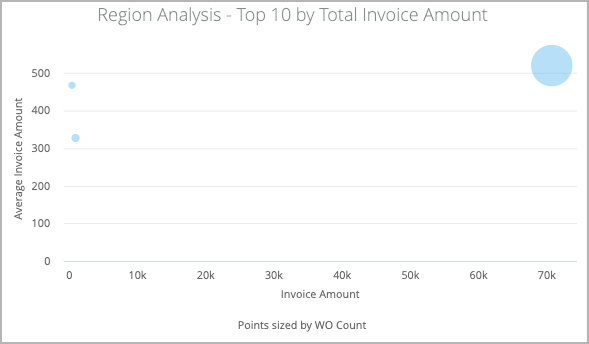
Top 15 Locations Report
This table gives you the top 15 Locations by Invoice Amount. Here, you can see which Locations have the highest volume in terms Invoice Amount, the volume of Work Orders, and the committed spend (both NTE Amounts and Invoice Amounts) for these Locations.
Voided work orders are excluded.
Clicking on the Work Order Count allows you to drill down into the data by Region, Feedback, or Asset. Clicking other metrics allow you to drill down to see more information such as work order details, NTE, and Committed Spend. Clicking the tracking number navigates you the work order details page in Service Automation.
Your access within Service Automation dictates your access to the work order details.
By default, this chart displays this data over the past 365 days; use the all-inclusive filters along the top of the report to change the date range.
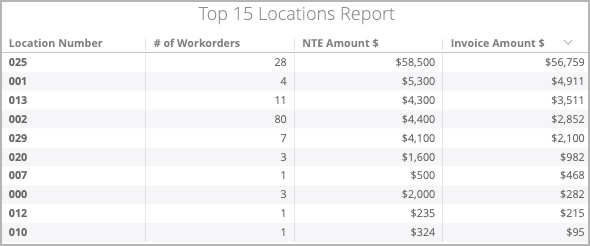
Work Order Count by State and Average Invoice Amount by State
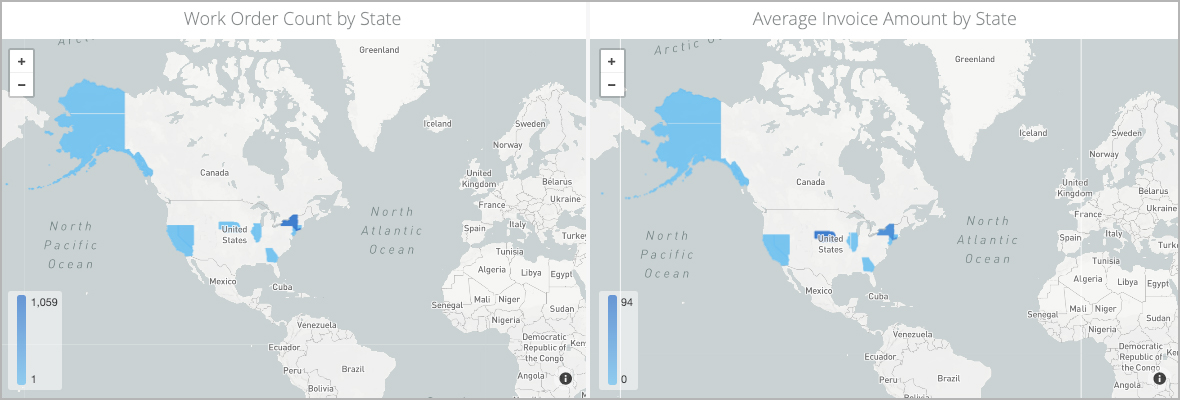
Both Work Order Count by State and Average Invoice Amount by State are similar, as they both help you quickly see work order volume or average invoice amounts, respectively, for all states and countries.
Each state or country with work orders is colored — the deeper the color, the higher the work order volume or average invoice amount. Zoom in by using the '+' and '-' buttons on the upper-left of each map.
Hover over a state or country to view respective details:
- Work Order Count by State: see the number of work orders; inside of the hover, click the Work Order Count to drill down into the list of all work orders, or filter by Region, Feedback, or Asset.
- Average Invoice Amount by State: see the average invoice amount; inside of the hover, click the Work Order Count to drill down into the list of all work orders, or filter by Trade, District, or Asset.
Commonly Used Features
Below is a quick reference guide regarding tracking numbers in Analytics, filtering, sorting, downloading data, and sending reports.
Tracking Numbers in Analytics
Throughout Analytics you can drill down into visualizations to see the underlying data. In most cases, the tracking numbers related to that data are listed. You can click the tracking number to navigate straight to the work order details in Service Automation.
Filtering Dashboards
On top of the report are all-inclusive filters to help you hone in on key data. All reports on the page are affected by the criteria set in these all-inclusive filters.
The filter criteria for each dashboard may differ. Filters reset to the default when the page is refreshed.
Click filter field to show the criteria.

Select the desired criteria to include or exclude:
To Include criteria: select is equal to, contains, starts with, or ends with, and then begin typing the criteria in the picklist. Select the desired criteria (or multiple criteria) from the picklist.
To exclude criteria: select is not equal to, does not contain, does not start with, or does not end with.
Is null depicts the absence of data in a data set. Conversely, is not null depicts the presence of data
To include or exclude data without a certain data criteria — for example, to select data without a Region or District assigned in Service Automation — choose is blank / is not blank.
To add more options, click the plus sign (+) next to a field to add another option to the filter. The new option will appear as either an OR condition or an AND condition, depending on the type of filter option.
Once all criteria are selected, click Refresh icon in the top-right corner. The Dashboard report updates with the selected criteria.
More details are available on Filtering an Analytics Dashboard
Dynamic Table Sorting
Analytics tables are dynamic, as you can:
- click column and row headers to sort data (the arrow indicate which data is sorted),
- hover over a header to show the gear icon where you can interact with the data more dynamically, and
- drag and drop a header to rearrange the table.
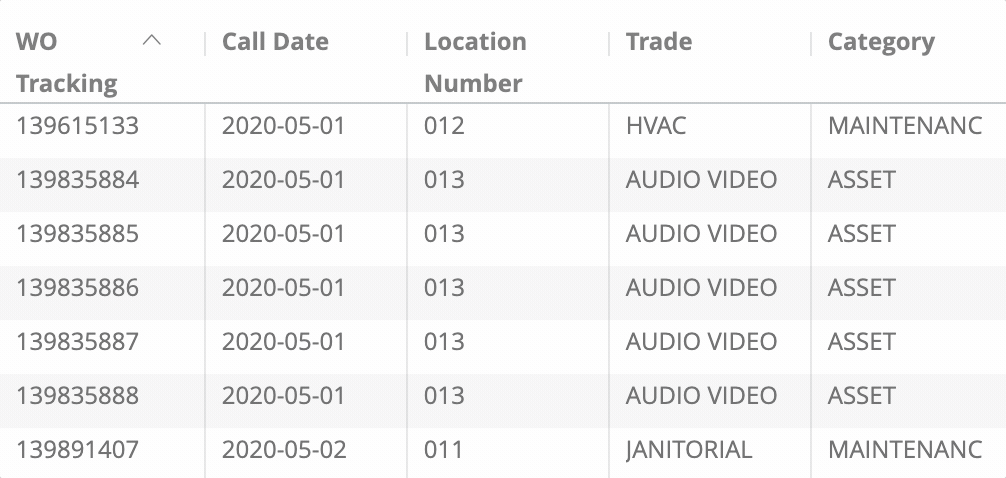
Downloading and Sending Reports
In the upper-right corner of any page, click the Vertical Ellipses to download reports, schedule delivery of reports at regular intervals, add to a board, or get a link.
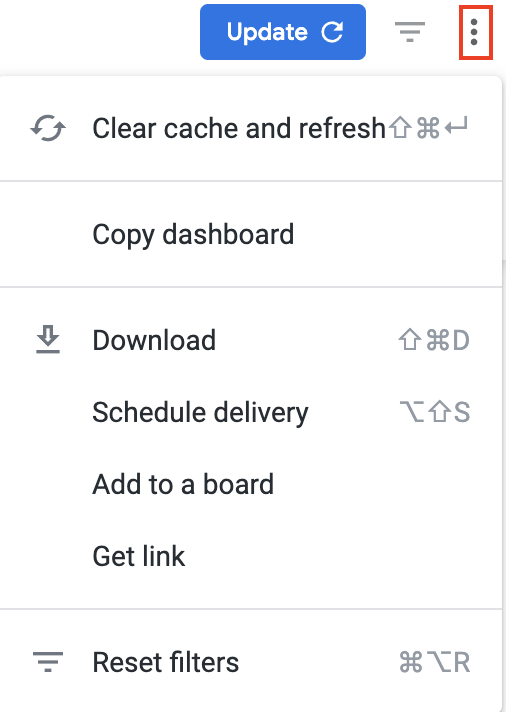
You can download data from a table and visualization or download a dashboard tabto PDF or CSV.
- On the desired table or visualization, hover over the upper-right to expose the 3 dots menu, and then click Download Data. The Download modal appears.

Select the desired File Format and choose a File Name: A default name is listed but you can change it.
- Click Download.
On the desired dashboard (or dashboard tab), click the Gear icon in the upper-right of the page, and then click Download as PDF. The Download modal appears.
A default Filename appears, but you can change it.
Under Advanced options:
Single-column format lays out all tables and visualizations on a page into one column in the PDF, as opposed to how it is laid out in the dashboard.
Expand tables shows all rows in a table, instead of just the rows that appear on the dashboard.
Paper size adjusts the PDF to your desired size.
Click Open in Browser to view the PDF in your chosen browser, or click Download to save a version of the report onto your device.
On the desired dashboard (or dashboard tab), click the Gear icon in the upper-right of the page, and then click Download as CSVs... A new browser tab opens.
After the files render, you are prompted to save the CSV Zip file onto your device.
More details are available on Downloading and Sending Dashboards and Reports
You can also Send a one-time report via email or Schedule a recurring email send.
On the desired dashboard (or dashboard tab), click the Gear icon in the upper-right of the page, and then click Send. The Send (Dashboard Name) modal opens.
A Title is given by default, but you can change it.
Under Who should it be emailed to?, enter the desired recipient(s), separated by a comma, and then click Add.
(Optional) Click Include a custom message to add a personal note.
Under Format data as, choose PDF, Visualization, or CSV Zip file.
(Optional): Click Filters to limit the criteria that appear in the email. Note that the same filters on the dashboard itself will also appear here.
Click Send. The email is sent to your recipients.
On the desired dashboard (or dashboard tab), click the Gear icon in the upper-right of the page, and then click Schedule. The Schedule (Dashboard Name) modal opens.
A Title is given by default, but you can change it.
Under Who should it be emailed to?, enter the desired recipient(s), separated by a comma, and then click Add.
(Optional) Click Include a custom message to add a personal note.
Under Format data as, choose PDF, Visualization, or CSV Zip file.
Under Deliver this schedule, choose Daily, Weekly, Monthly, Hourly, or By minute (in 5-minute increments, up to 30 minutes)
(Optional): Use Filters to limit the criteria that appear in the email. Note that the same filters on the dashboard itself will also appear here.
Click Send. The email is sent to your recipients.
More details are available on Downloading and Sending Dashboards and Reports
- No labels